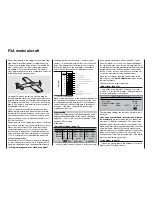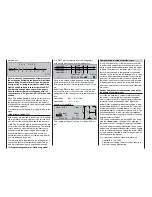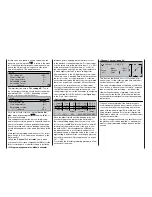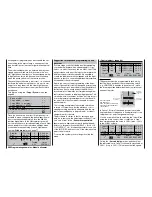
193
Programming examples: Fixed-wing model
0.0s 0.0s
0.0s 0.0s
0.0s 0.0s
SYM ASY
SEL
global
global
global
global
4
2
2
0.0s 0.0s
Channel 1
Aileron
Elevator
Rudder
Trim.step
Trim
– time +
2
You may fi nd it necessary to assign transmitter cont-
rols to particular inputs to operate the retractable un-
dercarriage and carburettor mixture adjustment. This
is carried out in the menu …
»Control adjust« (page 78)
+100%
«normal »
ASY
SYM
ASY
SYM
0%
+100%
0.0 0.0
Cnt. 5
4
0%
0%
+100%+100%
+100%+100%
+100%+100%
0.0 0.0
0.0 0.0
0.0 0.0
SEL
0%
SEL
Input 5
free
Input 6
Input 7
Input 8
free
–
–time+
offset
… where you might decide to select an ON / OFF
switch connected to Input 6 to operate the retracts,
and one of the two INC / DEC buttons, e. g. CON-
TROL 5, connected to Input 7, for mixture adjust-
ment. You will need to adjust the travel of the transmit-
ter controls; they can also be reversed if necessary by
setting negative travel values.
Note:
You may wish to set a time delay for the retracts, as
this provides a more realistic retraction / extension
speed, although this has no effect if you use the non-
proportional retract servo C713, Order No.
3887
.
F3A models generally fl y at extremely high speeds,
and respond very “solidly” to corrective movements
of the servos. However, in competition fl ying it is vi-
tal that all abrupt control movements and corrections
should be kept to a minimum, as the judges will inva-
riably notice any lack of smoothness and dock a few
fl ight points, so it is advisable to set exponential cont-
rol characteristics on the stick functions.
Switch to the menu …
»Dual Rate/Exponential« (page 86)
Exponential values of 30% on aileron, ele-
vator and rudder have proved to be a good star-
ting point, and you can set them in the right-hand co-
lumn of this menu using the rotary control. These va-
lues provide smooth, well-defi ned control of the typi-
cal F3A model.
100%
100%
DUAL
SEL
SEL
?
100%
+30%
+30%
+30%
EXPO
Aileron
Elevator
Rudder
(Many experts use higher values; even up to +60%
exponential.)
Since the response of (many) glowplug motors to the
throttle stick is by no means truly linear, you may want
to exploit the menu …
»Channel 1 curve« (page 90)
… to set what we might term a “bent”, i. e. non-linear,
throttle curve. In particular, four-stroke engines with
Roots superchargers, such as the OS Max FS 120,
call for a steep rise in the curve at the bottom end
of the speed range. However, you will need to expe-
riment to fi nd the perfect throttle curve. A typical C1
control curve for the motor might look like this:
0%
0%
m
OU
T
P
U
T
--
+
1
100
–50%
1
Input
Curve
on
Point
Output
Channel 1 C U R V E
Only three reference points, namely -100% cont-
rol travel (= “L, low”), +100% travel (= “H, high”) and -
50% control travel (“1”) produce the curve shown in
this screen-shot when rounded off.
Basic procedure:
1. Erase the reference point “1” which is present at
the centre point in the basic software setting by
moving the C1 stick to centre and pressing the
CLEAR
button at the side.
2. Now move the C1 stick – and with it the verti-
cal line in the graph – to around -50% travel, and
briefl y press the rotary control.
3. To obtain the curve shape shown here, use the ro-
tary control to raise this reference point to about
0% in the highlighted fi eld of the “Point” line.
4. Finally round off the curve by pressing the left-
hand
ENTER
button.
If you need to set additional reference points between
the left (“L”) and right (“H”) ends of the curve, repeat
steps 2 and 3 using the same procedure.
If you operate the radio control system in one of the
PCM modes, it is advisable to set up and store sui-
table fail-safe settings using the menu …
»Fail-safe adjust« (pages 146 … 149)
… since the default setting of the transmitter is “hold”
mode.
This equates to “do nothing”, i. e. the receiver con-
tinuously passes the last valid signals to the servos
in the model: it “holds them still”. This is more or less
the worst possible setting for a power model, and
might well ensure, for example, that the model would
tear uncontrollably across the fl ying fi eld, placing pi-
lots and spectators alike at serious risk of injury! For
this reason we strongly recommend that you should
at least set the motor to stop or throttle back, in order
to avoid precisely this risk; it also makes sense to lo-
wer the undercarriage, or leave it lowered. Once you
have made these settings you should certainly check
them again once the model has been test-fl own and
Summary of Contents for mx-24s
Page 1: ...1...
Page 19: ...19 For your notes...
Page 35: ...35 For your notes...
Page 41: ...41 41 For your notes...
Page 57: ...57 For your notes...
Page 63: ...63 63 For your notes...
Page 69: ...69 69 For your notes...
Page 85: ...85 85 For your notes...
Page 99: ...99 For your notes...
Page 143: ...143 For your notes...
Page 191: ...191 For your notes...
Page 212: ...212 212 For your notes...
Page 213: ...213 213 For your notes...
Page 214: ...214 For your notes...
Page 216: ...216...
















































